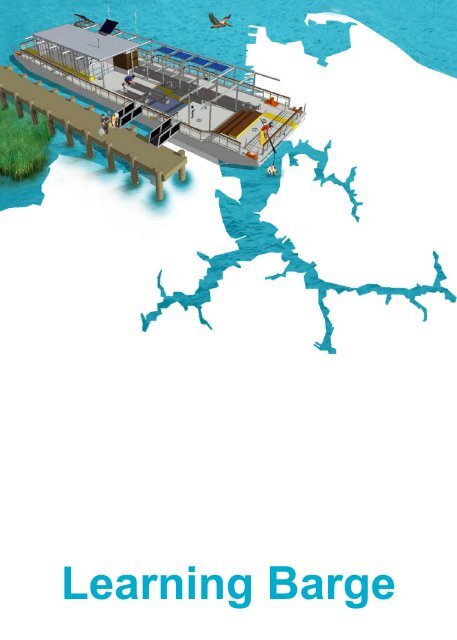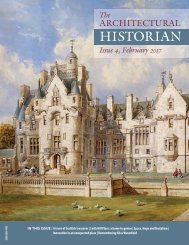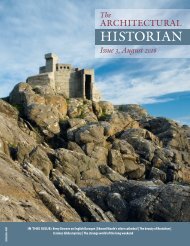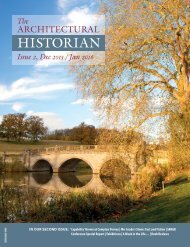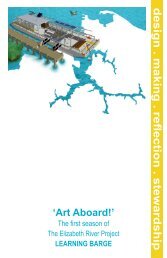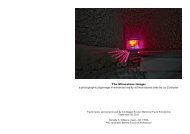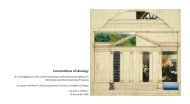You also want an ePaper? Increase the reach of your titles
YUMPU automatically turns print PDFs into web optimized ePapers that Google loves.
Learning Barge
The LEARNING BARGE<br />
is a unique sustainable<br />
classroom and floating<br />
wetland for the Elizabeth<br />
River, the southern-most<br />
tributary of the Chesapeake<br />
Bay. The Elizabeth River<br />
was once home to an<br />
abundant and diverse ecosystem but many centuries<br />
of port traffic, industrial operations, chemical accidents,<br />
and suburban growth have polluted the river. Founded<br />
in 1991, the non-profit Elizabeth River Project (ERP) has<br />
been working to restore the river. As part of the educational<br />
mission of the ERP, the LEARNING BARGE is a moveable<br />
education center powered solely by energy harvested from<br />
the sun and wind. As an off -the-grid vessel, the BARGE<br />
has a rainwater filtration system, composting toilets, and<br />
a variety of ‘green’ construction materials. The vessel was<br />
designed and built by students at the University of Virginia<br />
in collaboration with the ERP, a naval designer, engineers,<br />
steel workers, teachers, and members of the community.<br />
These <strong>cards</strong> were made possible by an Access to Artistic<br />
Excellence Grant from the National Endowment for the Arts.
Bow<br />
1<br />
6<br />
2<br />
Port<br />
Starboard<br />
5<br />
3<br />
4<br />
Stern
1. FISHABLE River:<br />
students interact with the<br />
Elizabeth River creatures<br />
and learn how runoff is<br />
the number one source of<br />
pollution in the river.<br />
2. RIVER Roots: while exploring the onboard<br />
wetland, students learn how plants and oysters are<br />
natural filters for the Elizabeth River.<br />
3. RIVER Lab: inside the classroom, students<br />
explore ‘green’ materials and learn how chemicals<br />
affect the health of the river and lead to detrimental<br />
algae blooms.<br />
4. SWIMMABLE River: on the aft deck, students<br />
discuss the importance of waste management in relation<br />
to reducing bacteria levels and creating a healthy river.<br />
5. GREEN Alley: students learn how using<br />
sustainable technologies, like solar and wind power<br />
systems, help conserve energy and reduce pollution.<br />
6. RIVER Art: students creatively express their<br />
experience with the Elizabeth River; by using the<br />
river for artistic inspiration, students learn to become<br />
conscientious river stewards.
Photovoltaic panels<br />
solar energy collection
The LEARNING BARGE uses photovoltaic panels,<br />
known as PV panels, as a source of renewable<br />
energy. The cells of a PV panel convert solar<br />
radiation from the sun into direct current electricity.<br />
The electricity collected by the eight Evergreen<br />
195W PV panels is stored in four batteries, located<br />
in the white deck box on GREEN Alley, then<br />
dispersed to elements such as lights. PV panels are<br />
most efficient when they are oriented perpendicular<br />
to the sun; however since the BARGE changes<br />
locations every season the panels were fixed in<br />
place. The humid climate and occasional cloud<br />
cover in the Elizabeth River area are actually<br />
beneficial factors for PV power: approximately 50<br />
to 80% of the light received is diffused light, making<br />
perfectly perpendicular PV orientation unnecessary.
Charge controller<br />
solar energy collection
The voltage and current generated by solar panels<br />
can be irregular due to temperature fluctuations.<br />
These irregularities cause the batteries to either<br />
overcharge or potentially discharge. Neither of<br />
these conditions are desirable because they<br />
strain the batteries beyond recommended<br />
levels, significantly reducing the life span of<br />
the batteries, and can even cause system<br />
failure. In order to eliminate these problems<br />
and control the system’s input vs. output the<br />
LEARNING BARGE uses a charge controller.<br />
A charge controller regulates the current flow<br />
and also delivers the maximum power using<br />
MPPT (maximum power point tracker). The<br />
MPPT displays the state of charge, meaning<br />
how much energy is stored in the batteries.
Monitoring system<br />
solar energy collection
The custom-designed wireless monitoring<br />
system consists of wireless sensors, a base<br />
station, and a data display board in order to<br />
collect, store, and display data related to the<br />
energy systems of the LEARNING BARGE.<br />
The DC wireless sensors monitor power<br />
generation (current and voltage) while the<br />
environmental condition sensors collect data on<br />
the temperature, humidity, wind speed, and the<br />
flow of the solar hot water heating system. The<br />
base station is the central part of the monitoring<br />
system. It serves as a hub to facilitate<br />
communication between various sensors and<br />
the data display board that shows visitors to<br />
the BARGE real-time feedback on the function<br />
and conditions of the power systems onboard.
Exterior lights<br />
solar powered
All of the lights on the LEARNING BARGE are<br />
powered by energy from the sun and wind.<br />
There two main light-types onboard are compact<br />
fluorescent (CFL) and light-emitting diode (LED). The<br />
CFLs along GREEN Alley are much ‘greener’ than<br />
typical incandescent light bulbs because they use<br />
less energy, last 8-15 times longer, and do not<br />
radiate heat. The CFLs on the BARGE have Edison<br />
screws, meaning they could be used on a traditional<br />
light fixture. LEDs are used to illuminate the ramp:<br />
these small, efficient lights have a long lifespan<br />
and use very little energy. The output of LEDs are<br />
more efficient than CFLs, however they are more<br />
expensive and require different current management.<br />
The BARGE has both AC and DC current , making it<br />
easy to showcase these two different light sources .
Evacuated tubes<br />
solar heat collection
There are two twenty-five tube solar thermal<br />
collectors by Solar Panels Plus on the LEARNING<br />
BARGE. Evacuated tube solar hot water heaters<br />
gather energy from the sun and transfer it to<br />
the water contained in the system’s piping. The<br />
circular design of the tubes allows sunlight to<br />
always strike the tubes at an optimal angle. The<br />
glass tubes are sealed and each one contains a<br />
thin copper tube filled with a very small amount<br />
of glycol and water. When heated by the sun’s<br />
energy, the liquid in the copper tube flash boils.<br />
The hot liquid is then pumped through insulated<br />
copper tubing to the hull of the BARGE, through<br />
the thermal mass of two hot water tanks, and<br />
then into the heaters in the RIVER Lab where<br />
it is converted to steam to heat the classroom.
Batteries<br />
solar energy collection
The LEARNING BARGE has four sealed East<br />
Penn AGM solar batteries. The batteries are stored<br />
in individual containers within the white, watertight<br />
dock box on GREEN Alley. Since the BARGE<br />
operates off-the-grid, a medium was needed to<br />
store the collected energy from the photovoltaic<br />
panels and wind turbines. The BARGE systems<br />
required batteries that could supply constant<br />
and steady current over long periods of time with<br />
constant drain/charge cycles while retaining high<br />
energy efficiency. The collective battery capacity of<br />
the BARGE was sized to provide power for 3 days<br />
if there was no sun or wind to generate additional<br />
energy. The system is also equipped with a shore<br />
power connection, similar to most boats, so the<br />
batteries can be manually charged if needed.
Hydronic heaters<br />
solar heat distribution
Beneath the benches in the RIVER Lab of the<br />
LEARNING BARGE are three Heatercraft 900h<br />
hydronic heaters. The heat comes from the<br />
evacuated tube solar hot water heating system.<br />
The evacuated tube collectors above GREEN<br />
Alley collect energy from the sun all summer<br />
to heat a closed-loop glycol water mixture<br />
then the heated water is stored in two large<br />
water tanks in the hull under the wetland. Two<br />
pumps, one located in bathroom closet and one<br />
located in the ‘dogshed’ below the bathrooms,<br />
control the flow of the water heating system.<br />
In the winter months the heaters in the<br />
classroom are switched on, drawing the hot<br />
water to make heat. The large windows of the<br />
RIVER Lab also help to keep the classroom<br />
temperature comfortable in the winter months<br />
since the direct solar radiation warms the space.
Lexan<br />
glazing
Lexan is a brand of highly durable polycarbonate<br />
resin thermoplastic and is often used on boats as<br />
an alternative to glass. It has a high impact strength<br />
as well as high resistance to heat, cold, water, UV<br />
light, and flame. Lexan was used on portions of<br />
the LEARNING BARGE’s Artifact Wall to provide<br />
clear views to the aft deck. Lexan also forms<br />
the outer layer of the one-of-a-kind light fixtures<br />
in the RIVER Lab. A graphic of the Elizabeth<br />
River’s own benthic fish, the mummichog, was<br />
engraved onto Lexan panels using a laser cutter.<br />
A similar engraving technique was used to create<br />
the images on the cabinet doors in the RIVER<br />
Lab. However, unlike the clear engravings on<br />
plexiglass, etchings on Lexan are a sepia color<br />
due to the UV protectant embedded in the material.
Thermoclear twinwall<br />
glazing
GE Lexan Thermoclear twinwall polycarbonate<br />
is a durable plastic material often used as<br />
roofing material for simple structures like sheds<br />
and bus stops. Onboard the LEARNING BARGE<br />
twinwall is used for parts of the Artifact Wall and<br />
the clerestory of the bathrooms. Twinwall is<br />
translucent and can be a better alternative to<br />
glass because it is both lightweight and has a<br />
ribbed structure that provides better insulating<br />
properties. It also diffuses light and blocks<br />
harmful UV rays due to an embedded film in the<br />
material. Unlike glass, twinwall will not shatter<br />
when broken, making the material particularly<br />
attractive for use on the BARGE since the<br />
Elizabeth River area experiences coastal<br />
storms and even the after-effects of hurricanes.
Laminated glass<br />
glazing
All of the steel windows of the LEARNING<br />
BARGE are composed of laminated glass.<br />
Double glazed windows were not used on<br />
the BARGE because the steel structure of the<br />
BARGE is an excellent thermal conductor and the<br />
insulation properties of double glazed windows<br />
were not beneficial. Laminated glass was<br />
used because the film embedded in the glass<br />
prevents the glass from dangerously shattering if<br />
broken. Instead, the glass remains in one piece<br />
but simply splinters in spiderweb-like patterns.<br />
Laminated glass is a more sustainable alternative<br />
to traditional window panes: during a storm,<br />
such as the strong coastal storms that strike<br />
the Elizabeth River region, broken glass stays<br />
in place rather than falling into the watershed.
Shadecloth<br />
sun protection
Instead of using air conditioning powered by fossil<br />
fuels, the LEARNING BARGE uses natural cooling<br />
techniques. Shade is created on the BARGE by<br />
the roof overhang and a special shade fabric that<br />
blocks harmful UV rays. Above the Storytelling<br />
Stairs and along the large windows of the RIVER<br />
Lab, there are custom-made shade devices using<br />
a product called Polysack. This shade fabric<br />
is typically used on farms and in greenhouses<br />
to keep plants and animals protected from the<br />
harsh sun, especially in southern climates.<br />
The shade cloth comes in different colors and<br />
woven patterns; the black shadecloth used on<br />
the BARGE provides 78-82% shade and blocks<br />
95% of UV rays but is visually translucent to<br />
retain views of the surrounding landscapes.
Barge color scheme<br />
reflectivity
The bright colors of the LEARNING BARGE reflect<br />
light, unlike dark colors often found on <strong>barge</strong>s that<br />
will absorb light. During the hot summers, the light<br />
grey of the deck and roof will help keep the vessel<br />
stay cooler. The bright orange and yellows are<br />
accent colors that highlight various components<br />
of the BARGE’s design. For example, the yellow<br />
stripe that wraps from the bow to the fore deck<br />
lines up with the longest filtration basin while<br />
the stern stripe aligns with the vibrant steel<br />
bench in the RIVER Lab. The pale yellow doors<br />
of GREEN Alley are painted with bright yellow<br />
stripes to mark the layers of the river. Even<br />
the bits are painted orange, and the cleats<br />
yellow, to call attention to typical components<br />
of a <strong>barge</strong> that usually go unnoticed by visitors.
Wind turbines<br />
energy collection
The two wind turbines on the LEARNING BARGE<br />
are AirBreeze 200W, made by Southwest<br />
Windpower. Humidity and cloud cover can<br />
reduce the effectiveness of photovoltaic panels<br />
but typically, gloomy days are paired with<br />
higher wind speeds so the BARGE uses wind<br />
turbines for extra energy collection. Unlike the<br />
sun’s predictable position, angle and seasonal<br />
movement, wind speeds, and frequency are<br />
variable especially in a coastal area like the<br />
Elizabeth River watershed. The BARGE team<br />
used data from the National Oceanic and<br />
Atmospheric Administration (NOAA) to predict<br />
wind patterns in the region: the average wind<br />
speed per month is approximately 15.75 feet<br />
per second. The marine-grade wind turbines<br />
used onboard have a low start speed so<br />
even small breezes can generate energy.
Operable windows<br />
ventilation
The custom-fabricated windows on the LEARNING<br />
BARGE are Bliss Nor-America steel windows<br />
and were designed with two specific sustainable<br />
elements. First, steel is the most widely recycled<br />
material in the United States: it produces less scrap<br />
and waste, has the highest strength to weight<br />
ratio of any building material, and is fire resistant.<br />
Second, the operable clerestory and casement<br />
windows, as well as the large, completely<br />
operable door to the RIVER Lab facilitate natural<br />
ventilation and keep the RIVER Lab cooler in the<br />
warm summer months without relying on fossil<br />
fuels for air conditioning. As a design feature,<br />
the large size of all the windows was intended to<br />
give unobstructed views of the Elizabeth River’s<br />
beautiful natural and industrial landscapes.
First-flush system<br />
water filtration
The bright orange first flush discharge tank on the<br />
LEARNING BARGE collects the first twenty gallons<br />
of water shed from the roof via the gutter. These first<br />
gallons have the greatest concentration of roof dirt so<br />
they flushed from the onboard water filtration system.<br />
The water is slowly released to the river via drip valve<br />
in the bottom of the tank. There is also a strainer<br />
and a filter at the bottom of the tank that are easy to<br />
remove for cleaning during the season, depending on<br />
how often it rains and the amount of airborne pollen<br />
or dirt present. The red ball valve, to the left of the<br />
first flush tank, controls whether water is sent directly<br />
overboard or is allowed to enter on-board water<br />
filtration system. During the BARGE’s off-season in<br />
the winter months, the water is sent directly overboard<br />
rather than being processed through the system.
Sand filter<br />
water filtration
After the collected rainwater from the roof of<br />
the LEARNING BARGE is processed through<br />
the first flush system it travels into a 600 gallon<br />
water holding tank in the hull of the BARGE.<br />
The water is then hand-pumped into a thirteen<br />
gallon priming tank, visible in the closet through<br />
the small window near the bathrooms. The<br />
water from this small holding tank then drains by<br />
gravity into the sand filter, made from a recycled<br />
rain barrel. The filter is composed of three<br />
layers: sand at the top, pea gravel in the middle,<br />
and coarse gravel at the bottom. The layers are<br />
separated by screens to make removal of the<br />
sand and gravel easier. As water slowly passes<br />
through the layers, contaminants are removed. A<br />
pipe at the bottom of sand filter carries the clean<br />
water into a 600 gallon holding tank in the hull.
Holding tank<br />
water system
The water used for hand washing on the LEARNING<br />
BARGE is collected from the roof and cleaned in a<br />
two-part filter system. The hand-pump on the wall<br />
between the two bathroom doors is used to pump<br />
water from the 600 gallon clean water tank in the<br />
hull into a custom-fabricated six gallon holding tank.<br />
The two sinks of the bathrooms are gravity fed by<br />
the water tank. The engraved lines on the tank are<br />
gallon markers: visitors can monitor how much water<br />
is being expended while the sinks of the bathrooms<br />
are in use. It is estimated that forty gallons/day of<br />
filtered rainwater are used onboard the BARGE for<br />
hand washing and other non-potable uses. With<br />
the BARGE’s visible lessons in water conservation,<br />
hopefully visitors will save water at home and<br />
work by turning off their faucets when not in use.
Concrete sinks<br />
water system
The two concrete sinks in the bathrooms of the<br />
LEARNING BARGE were custom designed and<br />
fabricated to show how an everyday material like<br />
concrete can be shaped into an object of art.. The<br />
concrete sinks were cast with smooth forms, unlike<br />
the concrete basins of the wetland, and a charcoalcolored<br />
pigment was added to the concrete mixture<br />
before it was cast to make the dark color. One sink<br />
is a trapezoidal shape while the other was cast to<br />
represent a topography model. This sink can be<br />
used to start a discussion about watersheds and<br />
how the contours of the earth shape where water<br />
travels. The back splashes of the sinks were also<br />
custom-made, with iconic BARGE-related details.<br />
Water from both of the sinks drains into the wetland<br />
onboard via steel channel cast into the concrete floor.
Cast iron hand pumps<br />
water filtration
Some of the concrete basins in the LEARNING<br />
BARGE’s wetland are for brackish water, a mix<br />
saltwater and freshwater, found the tidal estuary<br />
system of Elizabeth River. The two black cast<br />
iron hand pumps are used to pump water into<br />
these brackish basins. The piping below each<br />
of the hand pumps runs through the hull of the<br />
BARGE and is open to the Elizabeth River:<br />
visitors to the BARGE use kinetic energy to<br />
pump the lever in order to create suction in the<br />
pipe which draws water directly from the river.<br />
The piping attached to the hand pumps has<br />
a small diameter; a smaller surface area has<br />
a more efficient ratio of lift. The simple hand<br />
pumps used on the BARGE are similar to those<br />
used for shallow land wells across the world.
Hand bilge pump<br />
water system
The LEARNING BARGE uses two simple hand<br />
pumps along the exterior wall of the bathroom<br />
enclosure as critical components of the onboard<br />
water collection and filtration system. Each pump<br />
draws water from large holding tanks in the hull into<br />
smaller, visible tanks above deck. For example, the<br />
hand pump on the wall between the bathroom door<br />
pulls water from the clean water tanks into the clear<br />
six gallon holding tank that feeds the sinks onboard.<br />
The JABSCO hand pumps are actually small, adapted<br />
bilge pumps. Bilge pumps are typically used in the<br />
lowest compartments of ships in order to remove the<br />
bilge water collected from rough seas, deck drainage,<br />
or small leaks. The bilge water on the BARGE is<br />
managed with a different system and water comes<br />
from condensation along all the steel plates of the hull.
Concrete basins<br />
water filtration
The custom-made concrete basins of the<br />
LEARNING BARGE are an integral part of the<br />
constructed onboard treatment wetland, filtering both<br />
saline and freshwater. Wetlands remove pollutants<br />
from the water through the processes of settling and<br />
biological uptake. By pumping water from the river<br />
and from the BARGE’s greywater system into the<br />
filtration basins, water will be returned to the river<br />
cleaner. For example, “waste” water from handwashing<br />
drains into the freshwater basins: as the<br />
water flows between the basins, carried by recycled<br />
steel channels and pipes that have a rough texture<br />
to help oxygenate the water, the plants naturally<br />
filer containments. The concrete basins were castin-place<br />
with exterior plywood formwork: on certain<br />
basins you can clearly see imprints left by the wood.
Wetland pool<br />
water filtration
The LEARNING BARGE is the world’s first<br />
floating wetland, complete with rainwater reuse<br />
and saltwater filtration systems as well as a pool.<br />
This shallow pool is the first place water from<br />
the freshwater and saltwater basins meet: after<br />
the water flows through the respective concrete<br />
basins it flows out the recycled steel scuppers<br />
and into the pool. From there, the water settles<br />
and creates a concentrated ecosystem. Once the<br />
water level of the pool reaches the desired height,<br />
the plug can be removed to drain the now cleaner<br />
water back into the Elizabeth River. The pool also<br />
plays a large role in the programs of the BARGE<br />
that celebrate cultural traditions around the<br />
world that celebrate water such as water drums,<br />
lanterns, and parades across the yellow bridge.
Water tanks<br />
solar hot water heating
The solar hot water heating system of the LEARNING<br />
BARGE is mainly composed of two twenty-five tube<br />
arrays of evacuated tubes, a closed loop mixture<br />
of glycol and water, and three hydronic heaters.<br />
Two tanks, twenty feet long and two feet in diameter,<br />
are located in the BARGE’s hull under the wetland.<br />
They serve as the thermal mass for the heating system<br />
since the coiled, copper heat exchanger in each tank<br />
is connected to the closed loop heating system. In the<br />
summer months, when the sun is producing optimum<br />
energy, the evacuated tubes are activated and the<br />
closed loop system begins to heat the water of the<br />
two large water tanks. Completely powered by green<br />
technologies, the heating system uses the insulating<br />
properties of the warm water in the tanks to maintain<br />
heat through the closed loop in the winter months.
White Oak<br />
rain screen cladding
The rain screen of the LEARNING BARGE is a<br />
layered wall construction technique using standard<br />
stud walls with Borate treated lumber, exterior grade<br />
plywood, building paper, and White Oak cladding<br />
attached with stainless steel fasteners. Unlike a<br />
typical wall system, rain screens freely drain rain<br />
rather than inadvertently capturing it within the<br />
wall system thereby causing moisture and rotting<br />
problems. White Oak is naturally rot resistant<br />
and the wood used onboard was sustainably<br />
harvested from dead or dying trees by Appalachian<br />
Sustainable Development. The White Oak has<br />
been treated with eco-friendly AFM Clear Natural<br />
Penetrating Oil and several of the rain screen panels<br />
were engraved with a lasercutter to recognize<br />
the many generous donors for the BARGE.
Birch plywood<br />
cabinets
The custom-designed cabinetry in the<br />
LEARNING BARGE’s RIVER Lab is made from<br />
laminated Birch plywood. This beautiful, finish<br />
plywood is distinguished by its excellent strength,<br />
stiffness, and resistance to deform, all essential<br />
qualities for a marine environment. It has a high<br />
shear strength and impact resistance, which<br />
make it especially suitable for heavy-duty wall<br />
structures. The Birch cabinetry provides storage<br />
space and the three Murphy tables fold down for<br />
additional workspace. The Birch plywood has<br />
been treated with AFM Clear Natural Penetrating<br />
Oil, an environmentally friendly finish that<br />
highlights the woods’ natural glow. The ‘window<br />
seats’ and bottom compartments of the cabinetry<br />
have been treated with a natural black varnish.
Ipê<br />
lumber
The woods used to make most decks, benches, and<br />
handrails are treated with harsh chemicals in order<br />
to resist weathering. Over time, these chemicals<br />
seep into the ground and eventually contaminate<br />
watersheds. However, the wood used for railings<br />
and the benches of the Storytelling Stairs of the<br />
LEARNING BARGE will not leach chemicals since<br />
it is a unique type of wood called Ipê (pronounced<br />
‘e-pay’). It is a Brazilian hardwood that naturally<br />
resists rot, decay, insects, and mold without the<br />
toxic chemical treatments typically applied to<br />
other decking products. These qualities, as well<br />
as its natural resistance to fire, makes Ipê an<br />
environmentally conscientious choice. Overtime<br />
UV rays from the sun will change the color of the<br />
Ipê from reddish-brown to a bright silver or grey.
Borite-treated wood<br />
lumber
The greenish wood that is used for most outside<br />
decks, telephone poles, and even playgrounds<br />
is called pressure-treated lumber. It is weather<br />
resistant because the wood is treated with harsh<br />
chemicals like arsenic, copper, and other heavy<br />
metals; as the wood weathers and breaks down<br />
these chemicals leach into the ground and water.<br />
All of the lumber used on board the LEARNING<br />
BARGE is Borate-treated ‘eco-lumber’. Borates<br />
are natural mineral salts. The wood is soaked<br />
in the Borate solution, then dried. This process<br />
makes the treated wood pest-resistant without<br />
being toxic to humans or plants. Since the Borate<br />
treatment process does not cause the wood to<br />
turn green, like pressure treated strategies,<br />
the wood retains its beautiful natural color.
Composting toilets<br />
waste treatment
The toilets onboard the LEARNING BARGE<br />
are waterless remote composting toilets by<br />
Envirolet. Below each toilet is a unit in the<br />
hull of the BARGE that collects the compost.<br />
An aeration fan in the plastic unit continually<br />
runs, using harvested solar and wind power,<br />
in order to keep the compost decomposing<br />
at a uniform rate. Every week, a special<br />
composting mix and wood chips are added to<br />
the composting toilet units to further accelerate<br />
the composting process. Every few months<br />
the compost from the BARGE will be removed<br />
and used in wetland restoration. The toilets are<br />
ventilated by two simple, wind-driven fans that<br />
can be seen on the roof. The ventilation pipes<br />
are the black tubes visible in each bathroom.
Plants<br />
filtration
The custom-made filtration basins of the LEARNING<br />
BARGE are an experiment in constructed<br />
wetlands. The BARGE will always have freshwater<br />
and saltwater plants, but specific plants onboard<br />
may change from year to year depending on how<br />
they respond to the system. Plants may also be<br />
changed to investigate which ones filter particular<br />
pollutants at higher rates than others. The goal<br />
is that contaminants such as tributlytin (TBT),<br />
gasoline, oil, and enterococci are filtered out of<br />
the river water. By growing plants onboard that are<br />
native to the Elizabeth River’s wetlands, visitors<br />
to the BARGE can learn plant identification and<br />
see the beauty of the dynamic wetland up close.<br />
Notice how the taller plants are along GREEN<br />
Alley, forming an enclosure for the pool area below.
Grating<br />
walking surface
The bright yellow grating of the LEARNING<br />
BARGE used over the precast channel in the<br />
concrete floor in the bathroom and in the pool<br />
of the onboard wetland is a reclaimed material.<br />
Found in a University of Virginia Facilities<br />
Department storage unit, the BARGE team gave<br />
the abandoned grating new life on the BARGE.<br />
The reclaimed grating is DURAGRID Standard<br />
Pultruded Grating that is flame retardant and<br />
corrosion resistant. The material provides a nonskid<br />
surface and has low thermal conductivity.<br />
The benefits of the fiberglass grating over typical<br />
metal grating are that the yellow DURAGRID<br />
is almost maintenance-free, lightweight, and<br />
will outlast steel in even a submerged or<br />
saline environment like the Elizabeth River.
Ramp paint<br />
non-skid coating
All of the LEARNING BARGE’s grey deck<br />
surfaces are coated with non-skid paint, a<br />
simple aggregate added to the epoxy paint<br />
mixture, but the design team wanted to provide<br />
extra traction on the ramp’s surface. The ramp<br />
on the starboard side is a simple slope and<br />
navigates the BARGE’s two different deck<br />
heights. The non-skid paint on the ramp was<br />
made from recycled tires, ground into a fine pulp<br />
and added to the paint mixture. This sustainable<br />
technique of reusing a discarded material has<br />
been used on other <strong>barge</strong>s and Naval vessels.<br />
Tires are a commonly reused material on the<br />
Elizabeth River: some tugs boats even use<br />
discarded tires from airplanes as fenders,<br />
or bumpers, along the sides of the vessel.
Metal signs<br />
cladding
All of the signs and scrap metal pieces used in<br />
the two bathrooms of the LEARNING BARGE<br />
were rescued from landfills or procured from<br />
metal junk yards and recycling facilities. Attached<br />
to exterior grade plywood, the signs add colorful<br />
character to the bathroom, especially against<br />
the white paint intended to reflect light from the<br />
clerestory level. Composed of everyday objects,<br />
at one time considered trash, the collage walls<br />
are pieces of art. Road signs are typically made<br />
from aluminum treated with corrosion-resistant<br />
coatings as well as reflective sheetings, making<br />
it difficult to recycle the metal unless it is treated<br />
with a harsh chemical agent to strip the coatings.<br />
Therefore, many of the reclaimed signs on the<br />
BARGE have been given a rare second life.
Spuds<br />
anchoring
The LEARNING BARGE is equipped with<br />
two spuds on the port side. Spuds are the<br />
typical ‘anchors’ used on <strong>barge</strong>s: the spuds<br />
are cranked or pulled by a crane to the upright<br />
position (pictured on the front of this card) and<br />
then dropped into the water through the steel<br />
sleeves in the hull so that the pointed ends of the<br />
hollow steel tubes sink into the bed of the river.<br />
When both spuds are lowered, the BARGE is<br />
anchored by two points of connection and won’t<br />
easily drift or put stress on adjacent docks as<br />
tides change. The spuds on the BARGE can be<br />
raised and lowered using a manual hand crank:<br />
the mechanical advantage granted by the gears<br />
of the wench allows a single person to easily, but<br />
slowly, raise and lower the heavy steel tubes.
Cleats + bits<br />
anchoring
Boats are equipped with cleats, T-shaped<br />
protrusions from the deck, in order to have a<br />
secure point onboard to tie the boat’s line to a dock<br />
or other structure. On the LEARNING BARGE<br />
there are four steel cleats painted yellow. Since<br />
the BARGE was designed with two deck heights,<br />
to dock at both high and low sites, there are cleats<br />
on both the port and starboard sides. The BARGE<br />
is not a self-propelled vessel therefore the bright<br />
orange bits on the four corners of the deck are<br />
used for tug boats to tie line to the BARGE in<br />
order to push or pull the vessel to its next docking<br />
site. With bits on both the port and starboard<br />
sides, the BARGE has maximum flexibility in<br />
navigating site conditions since a tug boat can<br />
easily get the BARGE in and out from either side.


